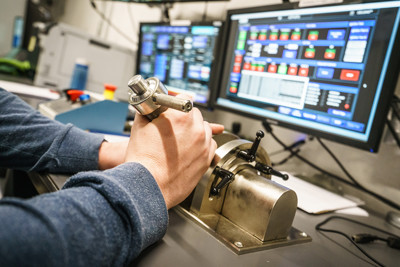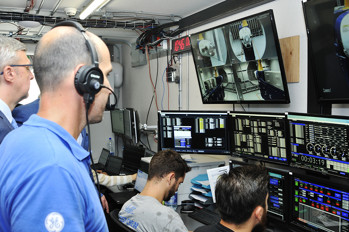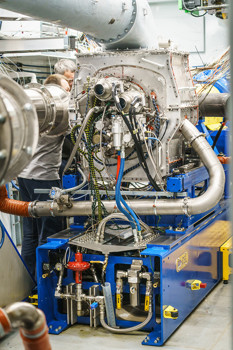Research infrastructure
LARGE RESEARCH INFRASTRUCTURE – ADVANCED AEROSPACE TECHNOLOGIES
Partners:- CTU in Prague, Faculty of Mechanical Engineering, Center of Aviation and Space Research
- Brno University of Technology INSTITUTEOFAEROSPACEENGINEERING
- CZECH AEROSPACE RESEARCH CENTRE
| CTU FME in Prague in connection with BUT FME and VZLU offers its research and experimental capacities in aerospace technologies. |
|---|
Experiments at aerospace testing laboratories FME CTU
 The Faculty of Mechanical Engineering of the Czech Technical University in Prague (FME CTU) operates its state-of-the-art
aerospace testing laboratories as the main part of its fulfilment to strengthen research and teaching capacities in aerospace
technologies. The current test cells are devoted mainly to turboprop engines. It is a dynamometer and core test facility
located in Prague - Letňany, two propeller test stands located in Hradec Králové and a flying test bed represented by an
experimental aircraft rebuilt in Berlin. The dynamometer, core and both propeller test rooms are fully operational and extensive
experiments are underway. Experimental turboprop engines have been acquired for these testing laboratories. Experimental engines
are equipped with several hundred to thousands of sensors of temperature, pressure, flow, speed, acceleration, voltage, while
the production engine is equipped with up to forty sensors. In order to fulfil this plan, EU structural funds have been secured
to support these ambitions. The implementation of a research project titled the Center of Advanced Aviation Technologies (CAAT)
led to the establishment of the Center for Aerospace Research (CASR) at the CTU FME. Within this framework, not only EU projects,
but also other projects, such as the National Center for Aerospace, are being addressed.
The Faculty of Mechanical Engineering of the Czech Technical University in Prague (FME CTU) operates its state-of-the-art
aerospace testing laboratories as the main part of its fulfilment to strengthen research and teaching capacities in aerospace
technologies. The current test cells are devoted mainly to turboprop engines. It is a dynamometer and core test facility
located in Prague - Letňany, two propeller test stands located in Hradec Králové and a flying test bed represented by an
experimental aircraft rebuilt in Berlin. The dynamometer, core and both propeller test rooms are fully operational and extensive
experiments are underway. Experimental turboprop engines have been acquired for these testing laboratories. Experimental engines
are equipped with several hundred to thousands of sensors of temperature, pressure, flow, speed, acceleration, voltage, while
the production engine is equipped with up to forty sensors. In order to fulfil this plan, EU structural funds have been secured
to support these ambitions. The implementation of a research project titled the Center of Advanced Aviation Technologies (CAAT)
led to the establishment of the Center for Aerospace Research (CASR) at the CTU FME. Within this framework, not only EU projects,
but also other projects, such as the National Center for Aerospace, are being addressed.
What experiments can be performed in these laboratories?
 The tested engine is started in all these test cells and its power/thrust is compensated/stopped in various ways. The dynamometer
test engine brakes the engine torque with a water dynamometer. The core test station stops hot gas flow by backpressure from
the compressors.
The tested engine is started in all these test cells and its power/thrust is compensated/stopped in various ways. The dynamometer
test engine brakes the engine torque with a water dynamometer. The core test station stops hot gas flow by backpressure from
the compressors.
At the propeller test cell, the engine is braked by air resistance to the propeller movement. All these test cells are generally
capable of bringing the engine under test to various operating modes and conditions that should not occur even during real
operation. Each test cell is suitable for a certain area of the examined conditions. Different engine behavior variables are
measured at different test cells with different accuracy.
How the experiment is carried out?
 The test of the engine is carried out in such a way that the engine is placed on the engine bed in a particular test cell
and its sensors are connected to the input channels and amplifiers of the test cell measuring system. It is programmed by
the data system into the control system of the test cell. The measurement is operated in low-frequency and high-frequency
modes (sampling up to 200 kHz). Due to the number of sensors, the wiring process takes three weeks. The engine is then started
and brought to the desired states according to the experiment plan. All this is done by a team of about five persons in the
control room. Furthermore, the entire test is monitored by a series of three to five-member teams monitoring various parts
of engine operation from a conference room equipped with computers connected to the test cell measuring system. These teams
analyze overall engine power, engine flow, engine vibration, fuel system and combustion, engine control - this is particularly
important for overall digital engine and propeller control.
The test of the engine is carried out in such a way that the engine is placed on the engine bed in a particular test cell
and its sensors are connected to the input channels and amplifiers of the test cell measuring system. It is programmed by
the data system into the control system of the test cell. The measurement is operated in low-frequency and high-frequency
modes (sampling up to 200 kHz). Due to the number of sensors, the wiring process takes three weeks. The engine is then started
and brought to the desired states according to the experiment plan. All this is done by a team of about five persons in the
control room. Furthermore, the entire test is monitored by a series of three to five-member teams monitoring various parts
of engine operation from a conference room equipped with computers connected to the test cell measuring system. These teams
analyze overall engine power, engine flow, engine vibration, fuel system and combustion, engine control - this is particularly
important for overall digital engine and propeller control.
On-going research
 On the one hand, there are experiments for research in the EU project and on the other hand experiments according to the Collaborative
Research Agreement with GE Aviation Czech. So far most of the experiments have been applicable for both purposes. The experiments
are primarily used for excellent research in the EU project consisting in measuring the engine properties with its wear, so
that this knowledge was inserted into its simulation model. The simulation model is parameterized according to engine wear
characteristics during its life cycle. This will create a digital twin engine about which “big data” in the “cloud”
will be collected using the Internet of Things. This will create an individual lifetime monitoring system for the functionality
and durability of predictive maintenance turboprop engines using Industry 4.0 concepts. Engine properties are individually
monitored and its usage history determines the settings of its simulation model properties. This is compared with the measured
characteristics of the engine and if there is no significant difference between them, the engine can be used further, if the
difference is significant, servicing is necessary.
On the one hand, there are experiments for research in the EU project and on the other hand experiments according to the Collaborative
Research Agreement with GE Aviation Czech. So far most of the experiments have been applicable for both purposes. The experiments
are primarily used for excellent research in the EU project consisting in measuring the engine properties with its wear, so
that this knowledge was inserted into its simulation model. The simulation model is parameterized according to engine wear
characteristics during its life cycle. This will create a digital twin engine about which “big data” in the “cloud”
will be collected using the Internet of Things. This will create an individual lifetime monitoring system for the functionality
and durability of predictive maintenance turboprop engines using Industry 4.0 concepts. Engine properties are individually
monitored and its usage history determines the settings of its simulation model properties. This is compared with the measured
characteristics of the engine and if there is no significant difference between them, the engine can be used further, if the
difference is significant, servicing is necessary.
Big data processing
The experiments produce a huge amount of data, about 60 TB of data after approximately one year of running the experiments on the dynamometer and propeller test cells. Such amount of data must be sorted according to the type of experiment, processed and used for research of the monitoring system. The obtained data are used for various research tasks. One is, for example, comparing the NPSS engine simulation model for different engine operation modes, as well as for changing model features and engine wear characteristics. Another is learning a neural network to predict the temperature distribution in an experimental engine measured by a large number of sensors based on the measurement of only a limited number of temperature sensors as on a normal engine. The evolution of the temperature field faithfully reflects the degree of engine wear, for example by changing the blade profiles by abrasion, oxidation, creep. Another area is vibrodiagnostics, where the change in vibration characteristics can be inferred from the state or even engine damage.
All these activities are a part of large ecosystem between FME CTU and GEAC with sharing, transferring and increasing knowledge and transmitting them to students.
Contact
Prof. Ing. Michael Valášek, DrSc.
e-mail: Michael.Valasek@fs.cvut.cz
Phone: +420 224 357 361
![[design/2014/cvut-logo-en-blue.png]](https://fs.cvut.cz/content/images/design/2014/cvut-logo-en-blue.png)
![[design/2014/cvut-logo-print.jpg]](https://fs.cvut.cz/content/images/design/2014/cvut-logo-print.jpg)